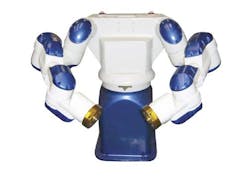Flexible Robots Mimic Humans
Watch for a new generation of highly flexible, industrial robots from Motoman Inc., West Carrollton, Ohio, that are designed to coexist with humans and closely mimic human capabilities.
Developed by Motoman’s Japanese parent—Yaskawa Electric Corp.—the Motoman IA20 and DA20 robots were unveiled during the Tokyo International Robot Exhibition, Nov. 30-Dec. 3. Both are planned for U.S. availability in the April or May timeframe, says Carl Traynor, Motoman senior director of marketing.
Snake-like
The IA20 is a seven-axis articulated, single-arm, 20-kilogram-payload robot that “shows the same level of flexibility as a human,” according to Yaskawa literature. Previously code-named internally as the “snake” robot, because of its extreme flexibility, the IA20 is capable of workpiece handling between machines in confined areas that are inaccessible to conventional robots, the company says. “You could position the IA20 between two machine tools, and it would be able to bend around and approach the front of the machine while the base of the robot would be physically beside the machine,” Traynor observes.
The DA20 is a dual-arm robot that is based on the same flexible arm structure as the IA20. Each DA20 arm features six axes of motion and a 20-kilogram payload capacity, and both arms are mounted on a torso with a rotational axis, providing a total of 13 axes of motion. Thanks to tightly coordinated motion of the dual arms using a single robot controller, the DA20 can perform tasks that were “once done only by people,” Motoman says, such as complicated assembly, bolt tightening or machine tending.
One key to the new robots’ dexterity is Yaskawa patent-pending actuator technology that “consolidates,” or “condenses” the servo motor, drive reducer and encoder for each axis into a compact cylindrical shape, says Traynor. “This allows the robot to exhibit snake-like flexibility,” he notes. The design enables a robot arm to “fold over on itself” and bring parts much closer to the robot body than is possible with traditional robot designs, Traynor says. The new flexibility can produce floor space savings of 50 percent or better for many factory tasks, he adds.
Man and machine
Among other features, the IA20 and DA20 also incorporate a “power assist” function that enables “coordinated labor of robots and humans.” With this capability, a human operator could allow the robot to do most of the lifting of a heavy component, while the operator physically guides the movement of the robot. “We’ve got a function called ‘servo float,’ in which the motors and drives are in a pliable status, so a person is able to flexibly move the robot arm,” Traynor explains. For applications such as assembly that involve the alignment of heavy parts, the power assist function will allow manufacturers to “address an ergonomic issue,” by eliminating the need for heavy lifting, while still “using a person as the guidance device.”
Traynor points out that the flexible technology deployed in the new Motoman robots has been proven at a major Japanese automaker, which has been using the robots for machine tending and other tasks. Until production volumes ramp up, pricing on the IA20 and DA20 will initially be at a “premium” over traditional robot pricing, he says. Smaller and larger payload versions of the new robots are expected in the future.

